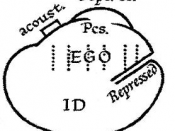William Wallace Hero or Herod?
An Analysis of William Wallace using the "Psychoanalytic Approach"
"William Wallace, a murderer, a runaway, a patriot, or a thief?" William Wallace led one of the first Scottish revolts against the English in the early 14th Century. His army defeated a much larger and much more powerful English army at Stirling Bridge, they captured Stirling Castle, and then ravaged northern England, for which Wallace was knighted and proclaimed guardian of the Scottish kingdom. In 1298 Edward I invaded Scotland and defeated Wallace at the Battle of Falkirk. Disgraced, Wallace resigned his guardianship and was replaced by the future Robert l but apparently continued to fight a guerrilla war. In 1305 he was arrested by the English and hanged, then disemboweled, beheaded, and quartered. The next year Robert raised the rebellion that eventually won independence for Scotland.
Sigmund Freud, the "father of psychoanalysis", prepared a summarized version of his theories of psychoanalysis.
Freud's theory breaks the psyche (mental life) of an individual into three portions: the id, the ego, and the superego, each with its own distinct function. William Wallace distinct personalities clash with each other, much like the id and the superego. With some thought and interpretation, these characters can be applied to Freud's theories. William Wallace was born in Elderslie, Scotland. Around the year 1270. He was the second of three sons of a middle class landowner Sir Malcolm Wallace. When William Wallace was fourteen he was sent off to live with his uncle where he received a church education, at seventeen his father, was killed by the English in the Battle of Loudoun. After the death of his father, William goes back home to live with his mother. There, he meets his wife, Murron who he knew from childhood. An English Sheriff...


